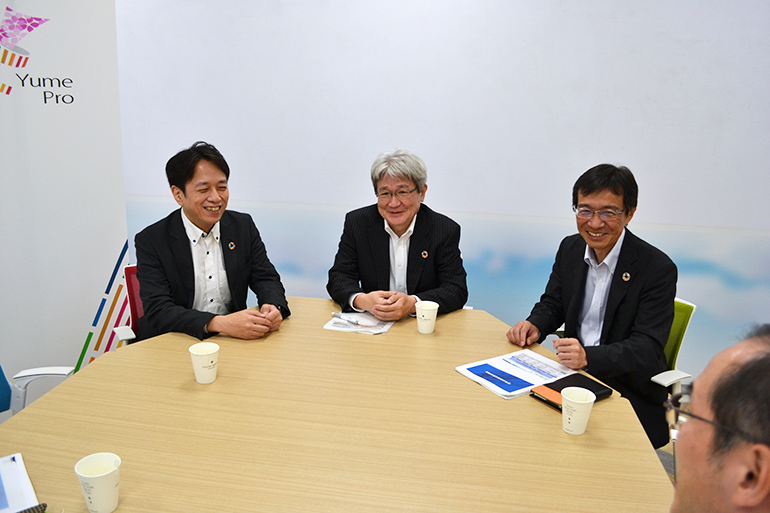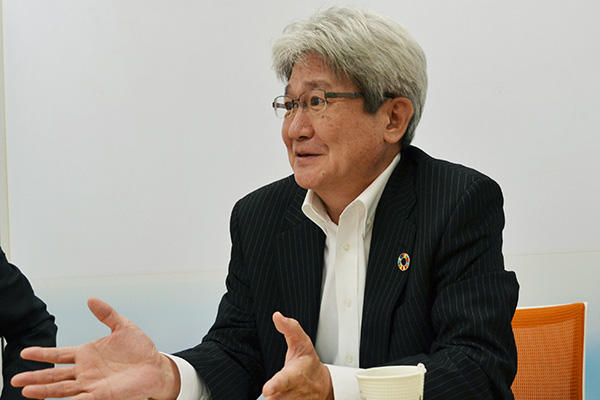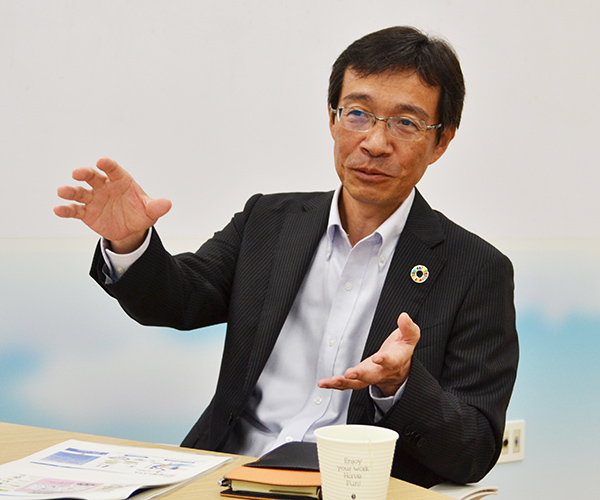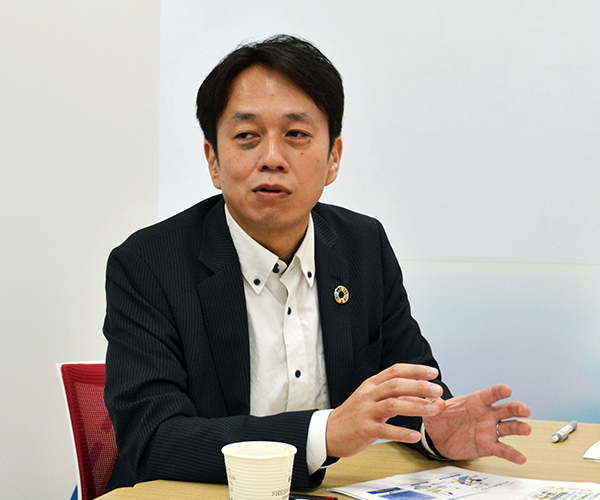Considering Upcoming Disaster Risk Management from Information Viewpoint
SUMMARY
OKI's Innovation Promotion Division seeks co-creation partners with whom innovations can be realized together in an aim to create new business opportunities. As a good innovation partner, "What can OKI do? What will OKI do?" - The key person behind each business will introduce the values and possibilities that OKI offers.
In this sixth round of talks, we welcome three key figures from the ICT Business Group's Social Infrastructure Solutions Division. Yukio Kato, Head of Social Infrastructure Solutions Division, Ryuji Otsuka, Senior Manager of Regional Business Unit, and Hiroaki Koshino, Senior Manager of Regional Solutions Department-1 will talk to us about the disaster prevention systems and businesses aimed at local governments with which OKI has years of experience.

Latest articles
Watching over the safe and comfortable lives of regional communities utilizing experience and technical strength cultivated at the forefront of disaster prevention
Give us the history and overview of OKI's disaster prevention business.
KatoSince its founding, OKI has accumulated years of experience working with communication technologies and developed a wireless telephone device in 1953. After that, with the occurrence of disasters such as the Niigata earthquake (1964) and the Tokachi-oki earthquake (1968), which caused extensive damage to the livelihood and industries during time of high economic growth, various disaster prevention systems have been introduced as part of the measure led by Japan's national government to strengthen disaster management at the local government level. At that time, telephone exchange technology was utilized for collecting and communicating disaster information within the area, so OKI quickly entered this field. Since then, OKI has been involved in the development and construction of various disaster prevention systems that respond promptly to the disaster prevention needs of the times, and supports disaster management of local governments.

Head of Social Infrastructure Solutions Division
ICT Business Group
Oki Electric Industry Co., Ltd.
OtsukaCurrently, in addition to the "fire command system/firefighting digital radio" and "municipal disaster management radio," each of which boasts top class market share in the industry respectively, "disaster monitoring system" that uses sensors and telemeters to monitor river and coastal water levels, and "disaster prevention information system" that supports information gathering, planning, analysis, processing and notification of disaster prevention work are offered.

Senior Manager, Regional Business Unit
Social Infrastructure Solutions Division
ICT Business Group
Oki Electric Industry Co., Ltd.
What is OKI's strength in the field of disaster prevention?
OtsukaWhen OKI first entered the market, our stance was to deliver systems that faithfully implemented the specifications imposed by customers such as local governments and firefighters. Since then, as we handled disaster prevention systems throughout the country, we heard live voices from regional administrators, firefighters and other disaster-related organizations, and we began promoting disaster prevention systems optimized according to the region. OKI's strength lies in its ability to design and realize disaster prevention systems with the fifty years of experience and knowledge it has under its belt.
Additionally, OKI possesses a series of disaster prevention related technologies from "device and sensing" for collecting on-site information with various sensors to "network" for transmitting the collected information, and on through to "data processing and operation" for analyzing, processing, sharing and distributing the information. I think the reason we can flexibly and actively propose and provide solutions matched to regional issues is because OKI is "just the right size" organization for merging various technologies.
Then, what is OKI's technical appeal in the field of disaster prevention?
KoshinoGenerally, in preparation for disasters, collaboration between self-help, mutual assistance and public assistance is important. For this to smoothly take place in the event of a disaster, accurate information collection, information analysis and processing, record of disaster responses, preliminary disaster action plan formulation and revision, and information distribution to related organizations, victims and local residents are required. I would like to emphasize that OKI can provide technologies and expertise to support such series of tasks. In particular, it is important to gather information at the endpoint (site) before a disaster occurs. As an example of a river monitoring device, let me introduce "zero energy ultrasonic water level gauge." The device integrates ultrasonic sensors with the 920MHz multihop wireless technology, which are both OKI's specialty, and enables water level monitoring at multiple points. Since the device runs on a solar battery, it does not require power cables and can be deployed easily, which enables to construct a disaster resistant system at low cost. We can provide solutions such as this that lessen operational burden.
Also, legacy administrative radio system using outdoor loudspeakers and household receivers is important for residents in mountainous or lightly-populated regions and elderly people. Therefore, we are also developing "speech clarification technology," which makes it easy to hear even during heavy rains and strong winds.
Tell us about your future goals and initiatives for "co-creation."
Koshino Foremost, we are thinking of expanding the use of sensor technology in which OKI is an expert. Currently, we are developing solutions such as the "inclination sensor" for use in landslide disasters, and for practical application, we are looking to accelerate co-creation partnership with experts in the field of geology and civil engineering. Furthermore, when a disaster occurs, in addition to numerical data from sensors, we believe real image information is required. Therefore, we are engaged in the implementation of a low-bitrate image distribution technology utilizing 920MHz multihop wireless.
With regard to information distribution, we are aiming not only to communicate information from the government to local residents, but also to create a mechanism for sharing information on self-help and mutual assistance utilizing SNS by co-creating with disaster and local community experts.

Senior Manager, Regional Solutions Department-1
Social Infrastructure Solutions Division
ICT Business Group
Oki Electric Industry Co., Ltd.
Finally, tell us what your division visions for the future.
Kato Aside from the disaster prevention field, the Social Infrastructure Solutions Division aims at deploying various businesses and technologies that support regional social infrastructure including power and energy management such as CEMS(*1), road traffic prediction, automatic driving, and bridge and tunnel monitoring. In times of disaster, smooth coordination with electric and gas, public transportation, and road administrators as well as government, firefighters and police is indispensable. Using 920MHz multihop wireless, LPWA(*2), DSRC(*3), LTE-V2X(*4) and 5G optical network, OKI will construct a "mesh local government network" optimized according to the regions characteristics. Regardless of whether situation is normal or in a state of emergency, regional information will be seamlessly integrated and utilized to support the realization of a safe and livable "smart city."
*1 CEMS(Community Energy Management System)
An integrated regional energy management system
*2 LPWA(Low Power Wide Area)
General term for a low-power wide-area wireless technology
*3 DSRC(Dedicated Short Range Communications)
Short-range wireless technology used for road-to-vehicle and inter-vehicle communication
*4 LTE-V2X(Long Term Evolution - Vehicle to X)
Automotive communication technology utilizing high-speed data communication of mobile phones






